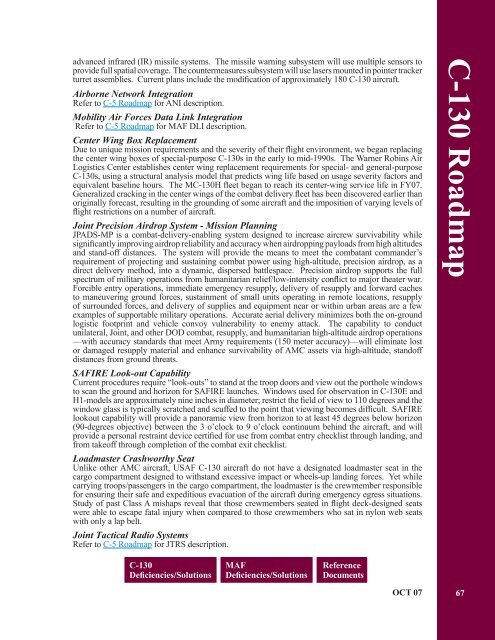Air Mobility Plan, 2008 - The Black Vault
Air Mobility Plan, 2008 - The Black Vault
Air Mobility Plan, 2008 - The Black Vault
Create successful ePaper yourself
Turn your PDF publications into a flip-book with our unique Google optimized e-Paper software.
advanced infrared (IR) missile systems. <strong>The</strong> missile warning subsystem will use multiple sensors to<br />
provide full spatial coverage. <strong>The</strong> countermeasures subsystem will use lasers mounted in pointer tracker<br />
turret assemblies. Current plans include the modification of approximately 180 C-130 aircraft.<br />
<strong>Air</strong>borne Network Integration<br />
Refer to C-5 Roadmap for ANI description.<br />
<strong>Mobility</strong> <strong>Air</strong> Forces Data Link Integration<br />
Refer to C-5 Roadmap for MAF DLI description.<br />
Center Wing Box Replacement<br />
Due to unique mission requirements and the severity of their flight environment, we began replacing<br />
the center wing boxes of special-purpose C-130s in the early to mid-1990s. <strong>The</strong> Warner Robins <strong>Air</strong><br />
Logistics Center establishes center wing replacement requirements for special- and general-purpose<br />
C-130s, using a structural analysis model that predicts wing life based on usage severity factors and<br />
equivalent baseline hours. <strong>The</strong> MC-130H fleet began to reach its center-wing service life in FY07.<br />
Generalized cracking in the center wings of the combat delivery fleet has been discovered earlier than<br />
originally forecast, resulting in the grounding of some aircraft and the imposition of varying levels of<br />
flight restrictions on a number of aircraft.<br />
Joint Precision <strong>Air</strong>drop System - Mission <strong>Plan</strong>ning<br />
JPADS-MP is a combat-delivery-enabling system designed to increase aircrew survivability while<br />
significantly improving airdrop reliability and accuracy when airdropping payloads from high altitudes<br />
and stand-off distances. <strong>The</strong> system will provide the means to meet the combatant commander’s<br />
requirement of projecting and sustaining combat power using high-altitude, precision airdrop, as a<br />
direct delivery method, into a dynamic, dispersed battlespace. Precision airdrop supports the full<br />
spectrum of military operations from humanitarian relief/low-intensity conflict to major theater war.<br />
Forcible entry operations, immediate emergency resupply, delivery of resupply and forward caches<br />
to maneuvering ground forces, sustainment of small units operating in remote locations, resupply<br />
of surrounded forces, and delivery of supplies and equipment near or within urban areas are a few<br />
examples of supportable military operations. Accurate aerial delivery minimizes both the on-ground<br />
logistic footprint and vehicle convoy vulnerability to enemy attack. <strong>The</strong> capability to conduct<br />
unilateral, Joint, and other DOD combat, resupply, and humanitarian high-altitude airdrop operations<br />
—with accuracy standards that meet Army requirements (150 meter accuracy)—will eliminate lost<br />
or damaged resupply material and enhance survivability of AMC assets via high-altitude, standoff<br />
distances from ground threats.<br />
SAFIRE Look-out Capability<br />
Current procedures require “look-outs” to stand at the troop doors and view out the porthole windows<br />
to scan the ground and horizon for SAFIRE launches. Windows used for observation in C-130E and<br />
H1-models are approximately nine inches in diameter; restrict the field of view to 110 degrees and the<br />
window glass is typically scratched and scuffed to the point that viewing becomes difficult. SAFIRE<br />
lookout capability will provide a panoramic view from horizon to at least 45 degrees below horizon<br />
(90-degrees objective) between the 3 o’clock to 9 o’clock continuum behind the aircraft, and will<br />
provide a personal restraint device certified for use from combat entry checklist through landing, and<br />
from takeoff through completion of the combat exit checklist.<br />
Loadmaster Crashworthy Seat<br />
Unlike other AMC aircraft, USAF C-130 aircraft do not have a designated loadmaster seat in the<br />
cargo compartment designed to withstand excessive impact or wheels-up landing forces. Yet while<br />
carrying troops/passengers in the cargo compartment, the loadmaster is the crewmember responsible<br />
for ensuring their safe and expeditious evacuation of the aircraft during emergency egress situations.<br />
Study of past Class A mishaps reveal that those crewmembers seated in flight deck-designed seats<br />
were able to escape fatal injury when compared to those crewmembers who sat in nylon web seats<br />
with only a lap belt.<br />
Joint Tactical Radio Systems<br />
Refer to C-5 Roadmap for JTRS description.<br />
C-130 Roadmap<br />
C-130<br />
Deficiencies/Solutions<br />
MAF<br />
Deficiencies/Solutions<br />
Reference<br />
Documents<br />
OCT 07 67
















